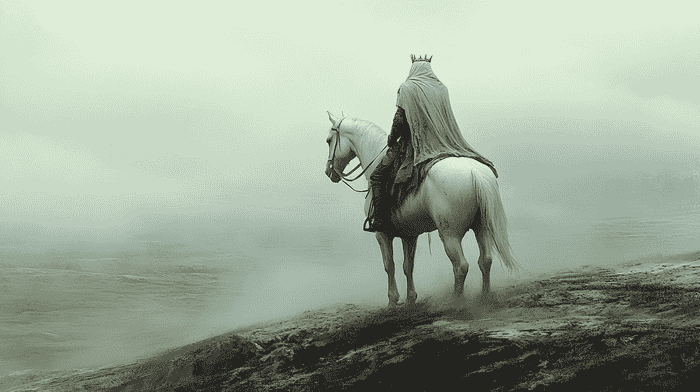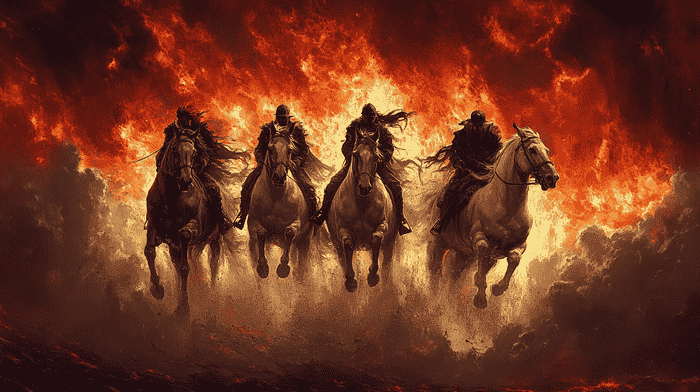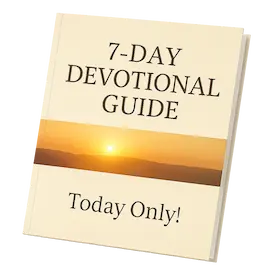What Do The Four Horsemen Represent? The Vision Itself
The Four Horsemen come galloping out of one of the most cryptic and unsettling scenes in the Bible: Revelation 6:1–8. It talks about a scroll with seven seals, a Lamb worthy to open them, and the sound of hoofbeats echoing through the end of the world.
“Now I saw when the Lamb opened one of the seals; and I heard one of the four living creatures saying with a voice like thunder, 'Come and see.” - Revelation 6:1, NKJV
It starts with a command: Come. One by one, the first four seals are broken, and each time, a rider appears.
Four horses. Four riders. Each bringing a different kind of devastation. But ask ten theologians what they mean, and you’ll get ten different timelines, warnings, or allegories. And maybe that’s part of their power, they’re flexible. Frighteningly so.
Now let's analyze each horseman.
1. The First Seal - The White Horse
“And I looked, and behold, a white horse. He who sat on it had a bow; and a crown was given to him, and he went out conquering and to conquer.” - Revelation 6:2 NKJV
The white horse is where things get complicated. A bow, but no arrows. A crown, but no kingdom. Some say this is Christ, spreading the Gospel. Others say it’s the Antichrist, wearing a crown that looks holy but isn’t. He doesn’t kill. He wins. Quietly, persuasively. And not necessarily for good.
2. The Second Seal - The Red Horse
“Another horse, fiery red, went out. And it was granted to the one who sat on it to take peace from the earth, and that people should kill one another; and there was given to him a great sword.” - Revelation 6:4 NKJV
There is less debate for the red horse. War has a way of making itself obvious. This rider doesn’t just start fights, he removes peace. And once peace is gone, people don’t need much help destroying each other. It's easy to imagine this as a global conflict.
But maybe it also speaks to the kind of chaos that starts smaller, within homes, cities, churches. Wherever peace is treated like a luxury instead of a necessity.
3. The Third Seal - The Black Horse
“So I looked, and behold, a black horse, and he who sat on it had a pair of scales in his hand. And I heard a voice in the midst of the four living creatures saying, 'A quart of wheat for a denarius, and three quarts of barley for a denarius; and do not harm the oil and the wine.’” - Revelation 6:5–6 NKJV
This rider with the black horse is measuring food. Carefully. Desperately. A denarius was a day’s wage, so imagine working all day and only being able to afford a handful of grain. The luxuries (oil and wine) remain untouched. Some eat well. Most starve.
This is famine, but not just hunger. It's the kind of economic collapse where survival becomes transactional. The image isn’t just about empty stomachs. It’s about injustice. A system that protects the wealthy and punishes the rest.
4. The Fourth Seal - The Pale Horse
“So I looked, and behold, a pale horse. And the name of him who sat on it was Death, and Hades followed with him. And power was given to them over a fourth of the earth, to kill with sword, with hunger, with death, and by the beasts of the earth.” - Revelation 6:8 NKJV
Death, plain and unhidden. And Hades, like a shadow behind him. A fourth of the world under his reach, by whatever means he chooses. This is the brutal unveiling of what happens when the seals are opened and judgment begins. The world doesn’t fall apart immediately. It unravels.
What ties them all together is permission. None of them acts on their own. Each is “given” authority, or allowed to ride. These aren’t wild forces. They’re unleashed ones. That’s the unsettling part.
The Bible doesn’t say God causes these things, but He doesn’t stop them either. Judgment here isn’t always loud. Sometimes it’s what happens when the guardrails are removed.

Depiction of the First Horseman (image generated with Midjourney)
How People Have Interpreted the 4 Horsemen
The Four Horsemen don’t come with an instruction manual. Revelation rarely does. And ever since it was written, people have been trying to figure out what this particular vision means. Is this about the past? The future? A spiritual warning? A historical map?
Depending on who you ask (and when), you’ll get a very different answer.
The Preterist view keeps things close to home. In this reading, the Horsemen were never about our future, they were John’s present. This is Rome. This is Jerusalem under siege. Revelation was a coded commentary on a brutal time, not a prediction.
The Historicist view zooms out. Way out. It treats the 4 Horsemen as part of a timeline that stretches across all of church history. Each rider marks a new era, an unfolding of world events that lead, eventually, to the final judgment.
It’s the long-game approach: the white horse might represent the early spread of Christianity; the red horse, centuries of warfare; the black horse, the economic decay of empires; and the pale horse, plagues and death across generations. For Historicists, the prophecy is history, just in disguise.
Then there’s the Futurist camp, probably the one most people encounter in modern end-times teaching. In this version, the Horsemen are still waiting in the wings. They’ll ride during a future period of global tribulation, an intense time of judgment that comes just before the return of Christ.
And finally, the Idealist view, which treats the vision less like a calendar and more like a recurring pattern. Here, the Horsemen aren’t tied to specific dates or empires. They represent the forces that move through every generation: conquest, violence, inequality, and death. They’re always riding, sometimes loudly, sometimes subtly.
What’s interesting is that none of these views can fully explain the text on their own. And maybe they’re not supposed to. Prophecy (especially apocalyptic prophecy) has a way of resisting neat answers. It speaks in layers. It holds up a mirror and asks: What do you see? Depending on your place in history, your theology, or even your mood that day, your answer might change.
But that doesn’t make it less true.
Get Closer to God Today
4.9
Average Rating
|Over 5 Million Downloads
Echoes from the Mount: What Jesus Said About the End
Long before the Horsemen were galloping through John’s vision on Patmos, Jesus sat with His disciples on the Mount of Olives and told them the world would unravel.
“Tell us, when will these things be? And what will be the sign of Your coming, and of the end of the age?” - Matthew 24:3 NKJV
What followed wasn’t a date or a checklist. It was a warning. Not unlike the one we find in Revelation. In fact, the parallels are hard to ignore.
“Take heed that no one deceives you. For many will come in My name, saying, 'I am the Christ,' and will deceive many. And you will hear of wars and rumors of wars. See that you are not troubled; for all these things must come to pass, but the end is not yet. For nation will rise against nation, and kingdom against kingdom. And there will be famines, pestilences, and earthquakes in various places." - Matthew 24:4–7 NKJV
Sound familiar?
- False messiahs and deception – like the first rider in white, who conquers without explanation.
- Wars and conflict – echoing the red horse’s mission to strip peace from the earth.
- Famines – the black horse’s weighted scales and desperate prices.
- Pestilence and death – carried in the wake of the pale horse, whose name is Death itself.
Jesus describes these things not as isolated disasters, but as “All these are the beginning of sorrows” (Matt. 24:8 NKJV). Something deeper is being born through the chaos. Or maybe exposed by it.
John’s vision doesn’t quote Jesus directly, but the structure is strikingly similar. The warnings line up, not just thematically, but almost step for step. Whether John was consciously echoing Jesus or simply receiving the same divine pattern, the takeaway is hard to miss.
The Horsemen aren’t an anomaly. They’re the continuation of a warning that started long before Revelation was ever written.

Depiction of the Third Horseman (image generated with Midjourney)
Are the Hooves Getting Louder? The Horsemen in a Modern World
It didn’t take long for the Horsemen to break out of the Bible and into the world’s imagination. You can see their hoofprints in medieval woodcuts, Cold War propaganda, comic books, and Twitter memes.
It’s easy to treat the Four Horsemen like myth. A dramatic vision from a different time. Ancient code for ancient chaos. But sometimes, if you look around, it’s hard not to wonder if they’ve just changed saddles.
The white horse, the one that rides out conquering, might not look like a lone figure with a bow anymore. But conquest hasn’t gone anywhere. Now it’s subtler. It wears suits. It signs contracts. It spreads through markets and influence, and ideology. Sometimes it brings peace. Sometimes it doesn’t. And it rarely asks permission.
The red horse, the one that takes peace from the earth, feels more familiar than most of us would like to admit. The last few years have seen wars we never imagined, and violence that now feels like background noise. Sometimes it's global. Sometimes it's just a neighbor yelling through the walls. Either way, peace feels... negotiable.
And then there’s the black horse. The one holding scales, rationing grain like gold. You don’t have to squint to see him today, just check the headlines. Food insecurity is rising. Cost of living crises keep sweeping across countries like the weather. Some dine out. Others ration lunch. The oil and wine are still untouched.
The pale horse has been riding too. Pandemic. Climate anxiety. The quiet fear that the systems we rely on (health, infrastructure, even the planet) are more fragile than we thought. Death has never needed much of an invitation.
The truth is, the Horsemen work because they tap into something primal. The idea that collapse doesn’t come from one place, it comes in waves. And maybe we’re not as in control of those waves as we’d like to think.
So they keep riding. In art, in media, in the back of our collective memory.
But maybe the most unsettling part is this: the Horsemen don’t announce themselves. They just show up in patterns, in data, in decisions we made years ago. And suddenly, the vision from Revelation doesn’t feel symbolic anymore. It feels diagnostic.
Still, this isn’t a call to panic. If anything, it’s a call to awareness. They show what happens when power goes unchecked, when peace is devalued, when justice is skewed, when death becomes normal.

Depiction of the Fourth Horseman (image generated with Midjourney)
Final Thoughts
The Four Horsemen aren’t just symbols of the end. They’re warnings about what happens when peace fades, justice slips, and the world looks away. Whether you see them as history, prophecy, or something unfolding right now, they force us to pay attention.
We’ve looked at how people have interpreted them, how Jesus echoed their message, and how they still show up in the headlines today. But there’s more to explore, and more beneath the surface.
If this stirred up questions (and it should), the Bible Chat App is a great place to keep digging. It’s built for tough passages like this: context, clarity, and conversation, all in one place.
Revelation doesn’t just reveal the end. It reveals us. Don’t stop here.
Get Closer to God Today
4.9
Average Rating
|Over 5 Million Downloads
References
Beale, G. K. The Book of Revelation: A Commentary on the Greek Text. Grand Rapids: Eerdmans, 1999.
Caird, G. B. A Commentary on the Revelation of St. John the Divine. New York: Harper & Row, 1966.
Collins, Adela Yarbro. Crisis and Catharsis: The Power of the Apocalypse. Philadelphia: Westminster Press, 1984.
Koester, Craig R. Revelation and the End of All Things. Grand Rapids: Eerdmans, 2001.










